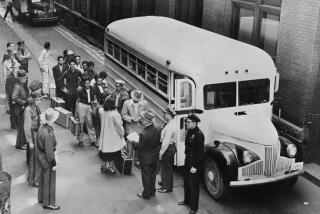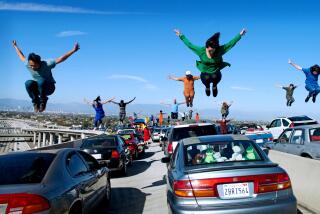Scavenging for Statues of Historic Figures
- Share via
Welcome to the First Annual Southern California Scavenger Hunt for Heroic Sculpture of Historic Figures.
The rules are simple, but winning won’t be easy. Classic statues are hard to come by these days. For those who care to play, however, the payoff will be well worth it.
The object is to locate sculptures memorializing great people in public spaces, but not churches or museums. Stumped already? Well, that’s understandable. After all, this isn’t Rome or Paris or Mexico City where such sculptures command prominent spots across the urban landscape. In some great cities, they put statues in major intersections so you have to drive around them or crash into your own history.
This isn’t even San Jose, my hometown, where the statue of a flag-waving guy on horseback has been a matter of public debate for more than a decade. His name is Capt. Thomas Fallon, said to be the first American to unfurl the Stars and Stripes in town during the Mexican War of 1846-48.
The bronze sculpture depicting Fallon in full gallop created a hue and cry among Mexican Americans after it was commissioned in the late 1980s. Critics said the city had no business paying tribute to a divisive figure who represented an American era of conquest based on racial superiority.
Besides, as it turns out, Fallon was a bit of a scoundrel. According to local historians, he once shot a French fur trapper in the back, cheated two priests who sued him, and had a dalliance with the household maid until caught by Mrs. Fallon, who attacked the woman with a hot fireplace poker. Oh, and the captain never fought any battles in that war with Mexico, though he said he did.
Is this the kind of character taxpayers should put on a $445,000 pedestal, critics wondered. The debate got so hot that the offending statue, in all its 2-ton glory, had to be stored out of sight for 10 years. Then in April, the controversy came charging back when city fathers finally resurrected Fallon, also a former mayor and developer. To the hissing of protesters, they let him take his place in an out-of-the-way park.
Amateur poet Nancy Pyne Walker won a local newspaper contest by deftly capturing San Jose’s civic dilemma in verse: A figure astride a fine horse/ In the conquering stance, of course./ A traditional hero? Or still batting zero?/ Whichever, he shows no remorse.
The modern war over this obscure historical footnote made me realize that Southern California could use a few statues worth fighting for. Except for certain icons like John Wayne at the Orange County airport that bears his name, we seem to have swept our historic sculptures aside, as if abdicating our duty to define ourselves through our heroes.
So I devised the sculpture scavenger hunt. I got a head start on the game when I recently chanced across the bronze figure of a bearded man with a long coat overlooking the entrance to Cabrillo Coastal Park in San Pedro. He stands glorious but hidden on a humble traffic island along a narrow residential side street named after him.
The plaque is legible only if you park and hop out onto the grassy island. His name is Sen. Stephen M. White, a 19th century politician who led the fight to establish the Los Angeles harbor there rather than in Santa Monica, which was the choice of powerful railroad barons. The political struggle led to his untimely death in 1901 at age 48, the inscription explains.
See what you can learn if you get out and walk around?
That’s what Joe Smoke wishes people would do. The manager of Los Angeles’ public arts collection is pushing a plan to catalog and spotlight the 2,000 items in “our museum of the streets.” They include 34 city-owned statues or busts of famous people, from Emiliano Zapata and James Dean to Beethoven, Leif Ericson and Pancho Villa. (Nine of them are located in Parque de Mexico in East L.A.’s Lincoln Park. Mexicans still love their statues.)
“I personally wish that our statues would scream out with voices,” said Smoke, who would like to see walking tours and other ways of introducing people to their public art.
Historically, statues served ruling classes as “emblems of surveillance, designed to make people feel small,” explained UCLA art history professor Albert Boime. But they also served as focal points for community, places where people of all classes met and spent time together in public.
Today, statues are as out of fashion as pedestrians. Our car culture keeps us from standing still long enough to see them, much less appreciate them. “In our sprawling metropolis,” Boime told me, “you don’t have these kinds of nodal points.”
Well, we do. We just have to hunt for them.
*
Agustin Gurza’s column appears Tuesday and Saturday. Readers can reach Gurza at (714) 966-7712 or agustin.gurza@latimes.com.
More to Read
The biggest entertainment stories
Get our big stories about Hollywood, film, television, music, arts, culture and more right in your inbox as soon as they publish.
You may occasionally receive promotional content from the Los Angeles Times.










